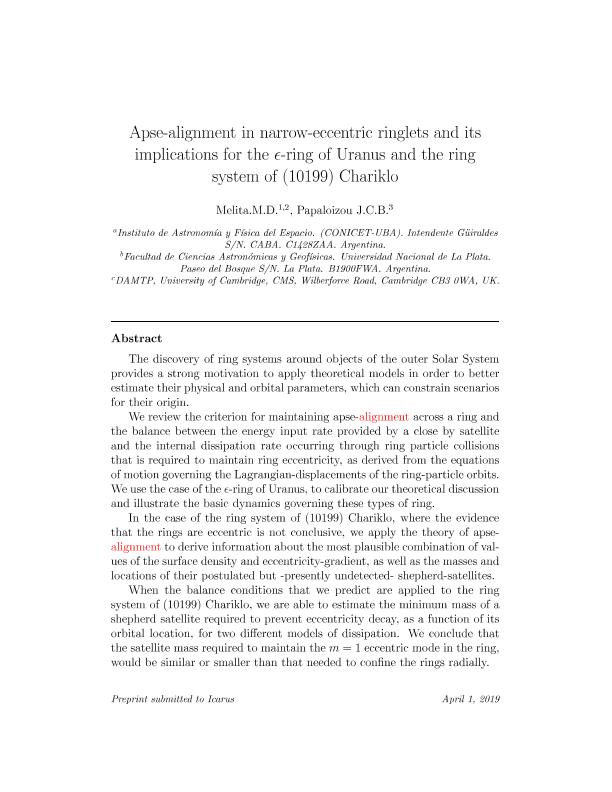Mostrar el registro sencillo del ítem
dc.contributor.author
Melita, Mario Daniel

dc.contributor.author
Papaloizou, J. C. B.
dc.date.available
2022-12-16T19:29:22Z
dc.date.issued
2020-01-01
dc.identifier.citation
Melita, Mario Daniel; Papaloizou, J. C. B.; Apse-alignment in narrow-eccentric ringlets and its implications for the ϵ-ring of Uranus and the ring system of (10199) Chariklo; Academic Press Inc Elsevier Science; Icarus; 335; 1; 1-1-2020; 1-44
dc.identifier.issn
0019-1035
dc.identifier.uri
http://hdl.handle.net/11336/181624
dc.description.abstract
The discovery of ring systems around objects of the outer Solar System provides a strong motivation to apply theoretical models in order to better estimate their physical and orbital parameters, which can constrain scenarios for their origin. We review the criterion for maintaining apse-alignment across a ring and the balance between the energy input rate provided by a close by satellite and the internal dissipation rate occurring through ring particle collisions that is required to maintain ring eccentricity, as derived from the equations of motion governing the Lagrangian-displacements of the ring-particle orbits. We use the case of the ϵ-ring of Uranus, to calibrate our theoretical discussion and illustrate the basic dynamics governing these types of ring. In the case of the ring system of (10199) Chariklo, where the evidence that the rings are eccentric is not conclusive, we apply the theory of apse-alignment to derive information about the most plausible combination of values of the surface density and eccentricity-gradient, as well as the masses and locations of their postulated but - presently undetected - shepherd-satellites. When the balance conditions that we predict are applied to the ring system of (10199) Chariklo, we are able to estimate the minimum mass of a shepherd satellite required to prevent eccentricity decay, as a function of its orbital location, for two different models of dissipation. We conclude that the satellite mass required to maintain the m = 1 eccentric mode in the ring, would be similar or smaller than that needed to confine the rings radially. Our estimation of the most plausible combinations of eccentricity gradient and surface density consistent with apse-alignment are based on a standard model for the radial form of the surface density distribution, which approximately agrees with the optical depth profile derived by the stellar occultations. We find a diverse range of solutions, with combinations of eccentricity gradient and surface mass density that tend to minimize required enhanced collisional effects, having adopted estimated values of the form factor of the second degree harmonic of the gravitational potential.
dc.format
application/pdf
dc.language.iso
eng
dc.publisher
Academic Press Inc Elsevier Science

dc.rights
info:eu-repo/semantics/openAccess
dc.rights.uri
https://creativecommons.org/licenses/by-nc-sa/2.5/ar/
dc.subject
CENTAURS
dc.subject
PLANET-DISK INTERACTIONS
dc.subject
PLANETARY
dc.subject
RESONANCES
dc.subject
RINGS
dc.subject
RINGS
dc.subject
URANUS RINGS
dc.subject.classification
Otras Ciencias Naturales y Exactas

dc.subject.classification
Otras Ciencias Naturales y Exactas

dc.subject.classification
CIENCIAS NATURALES Y EXACTAS

dc.title
Apse-alignment in narrow-eccentric ringlets and its implications for the ϵ-ring of Uranus and the ring system of (10199) Chariklo
dc.type
info:eu-repo/semantics/article
dc.type
info:ar-repo/semantics/artículo
dc.type
info:eu-repo/semantics/publishedVersion
dc.date.updated
2020-11-18T17:29:47Z
dc.identifier.eissn
1090-2643
dc.journal.volume
335
dc.journal.number
1
dc.journal.pagination
1-44
dc.journal.pais
Estados Unidos

dc.journal.ciudad
Nueva York
dc.description.fil
Fil: Melita, Mario Daniel. Universidad Nacional de La Plata. Facultad de Ciencias Astronómicas y Geofísicas; Argentina. Consejo Nacional de Investigaciones Científicas y Técnicas. Oficina de Coordinación Administrativa Ciudad Universitaria. Instituto de Astronomía y Física del Espacio. - Universidad de Buenos Aires. Facultad de Ciencias Exactas y Naturales. Instituto de Astronomía y Física del Espacio; Argentina
dc.description.fil
Fil: Papaloizou, J. C. B.. University of Cambridge; Reino Unido
dc.journal.title
Icarus

dc.relation.alternativeid
info:eu-repo/semantics/altIdentifier/url/https://www.sciencedirect.com/science/article/pii/S0019103518307991
dc.relation.alternativeid
info:eu-repo/semantics/altIdentifier/doi/https://doi.org/10.1016/j.icarus.2019.06.027
dc.relation.alternativeid
info:eu-repo/semantics/altIdentifier/url/https://arxiv.org/abs/1907.02391
Archivos asociados
